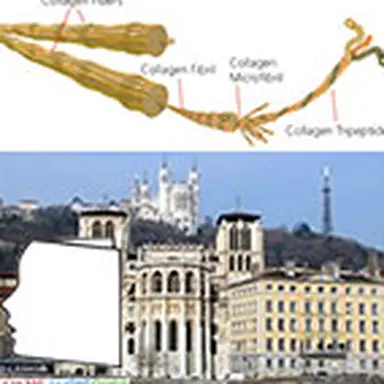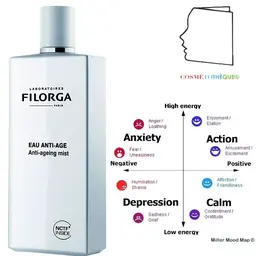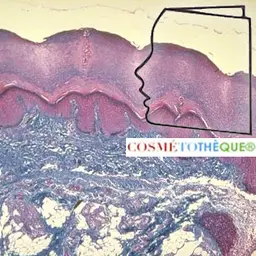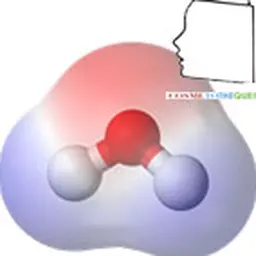
The cosmetics industry, after having used for many years ingredients often of rather little or poorly defined composition, selected mainly for their propertiesIn the course of time, the use of supposed biological teas has become more and more oriented towards the use of increasingly better characterized substances and especially in direct relation with notions of cutaneous physiology.
Collagen was one of the very first star ingredients put forward by the cosmetics industry. Let us go back a bit to the way things happened.
Collagen constitutes a very large family of proteins, most often in fibrillar form, present in the extracellular matrix of many organisms. The function of these proteins is to give tissues mechanical resistance to stretching. They are the most abundant proteins in a human organism, as in the whole animal kingdom, representing practically a quarter of the protein mass. Collagen is secreted by the competent connective tissue cells, fibroblasts, and has a molecular weight of about 300 k Da . There are different types, depending on the body concerned. He is also heavily involved in healing processes.
The term collagen means"glue producer" (the name comes from the Greek word kolla meaning"glue"). Its properties were used by the Egyptians 2000 BC. The Amerindians used it in the 5th century. The oldest known glue is made from collagen, and dates from 6000 years BC.
From an industrial and economic point of view, collagen is the raw material for gelatin production. When partially hydrolyzed, the three strands of tropocollagen dissociate. They thus form gelatin. It has also been used in the pharmaceutical industry, cosmetics and photography. Another ancestral collagen industry is tanning or leather industry . The leather is nothing other than collagen of the dermis specially treated with tanning agents, i.e. bridged in a special way, to give it flexibility and resistance. A variant of this industry is that of the conservation of human animals or corpses (mummification): the tanning of the dermis allows the conservation of teguments by protecting them from bacterial degradation.
It is therefore a substance that has been known for many years. But it is neither in the form of glue, nor in the form of gelatin that this ingredient will know glory, but more specifically for its role in the skin and during skin aging.
The first uses of collagen in a beauty cream are quite old, and one can find traces of its use since 1936 . The intensification of its use by the cosmetics industry began in the 1970s. This comes from studies conducted on skin aging. Its role in the skin had long been known, but many teams then showed the changes in the extracellular matrix during skin aging, and, in particular, the role and involvement of collagen in aging. To understand aging, the teams were interested in the cells but also in the intercellular matrix. This substance constitutes a solid framework of higher organisms. It is composed of glycoproteins of structures in which collagen is a central actor. This substance is the interface between the cells and their environment and numerous research teams have shown that this matrix plays an essential role in aging. The composition changes in the intercellular matrix e were then established with great precision. Several types of collagen were then described, 28 to date. A theory was then established, with the notion of soluble and insoluble collagen, and the idea that the ratio between these two variants played an important role in matrix ageing. The idea of trying to intervene on the mechanisms at the origin of the modifications of this ratio will become one of the classic approaches in the prevention or accompaniment of ageing. It is on this theory that many products will be born. This trend remains quite active even after almost 50 years!
The first step will be to use extracts based on non-crosslinked soluble collagen, known as"native collagen". Then to protect the uncrosslinked collagen stock from degradation by lytic enzymes. This will correspond to the use of protease inhibitors, anti-collagenase in particular. We will then try to boost the production of native collagen, with the reign of the active biopeptides such as Matrixyl™ . Then we'll try to inhibit MMP production. Finally, it will interfere with the genomic expression of the corresponding macromolecules.
Let us therefore return to the first stage of this saga, namely the use of native collagen solutions. It is a collagen in its natural form in triple helix. It was first obtained from the skins of young animals. The extraction techniques tend to avoid denaturation and preserve the initial structure of this non-crosslinked collagen. The final result is aqueous solutions of native collagen. These are the solutions from which the cosmetics industry will develop products around the theme of collagen protection. Many formulas will exist within prestigious brands, but also in other more specialized circuits.
If there are many uses, suppliers of this type of ingredient will be fewer. One of the main players in this field of activity was represented by a German company, homonymous with the great tannin specialist Karl Freudenberg. The demand for this type of derivative will grow very rapidly, generating strong demand, which will attract new players. Bioetica, now Coletica, will be one of these new entrants. This will correspond to the birth of a very active sector in the Lyon region.
Jean-Claude Le Joliff
Lyon's collagen saga
The work in Lyon in the field of connective tissue began at the technical centre for leather, the CTC, in the 1960s.
This research centre was created to carry out research for the leather, leather goods and footwear industries. In the 1970s, Professor G. Vallet, Chair of macromolecules at the University of Lyon, was entrusted with the management of this organization. Immediately, this scientist understood that, to know the skin well, it was necessary to study its basic protein, namely collagen. He therefore created a collagen research unit within the CTC.
This structure then worked in relation with a laboratory of the University of Lyon led by Daniel Herbage, researcher at Inserm, specialist in connective tissue. The applied research was done by our team at the CLC, and the more fundamental work by the university. The results obtained led to the development of protein waste recovery processes in the leather industry and a better understanding of tanning techniques.
At that time, the French leather industry was in a declining phase and CLC administrators found our work too theoretical and too far removed from the immediate concerns of industrialists. Our team's existence seemed threatened at the time. That's when luck smiles on us!
On the occasion of the European Conjunctive Fabric Days held in Lyon, we met Mr Koulbanis, Director of Applied Research at L'Oréal. This colourful person told us, in an inimitable Greek accent, of his concern to find a source of French collagen for one of the creams that the L'Oréal group had just launched on the market. Until then, its only supplier had been German. He asked our team to develop a collagen solution that could be used for cosmetic purposes.
We immediately understood that a path of diversification was opening up to us. The collagen solution was developed and approved by L'Oréal. Production then began, with Gattefossé taking over distribution. Very quickly, the quantities ordered were important, and, by its statutes, the technical center of leather could not ensure any more the production of it.
To take over from our team, a company was created in 1976, Saduc, in which the directors and certain employees were shareholders.
To apprehend the scepticism that prevailed during the launch of collagen as a cosmetic active, it is appropriate to report the intervention of Deputy Pierre Juquin in the gallery of the National Assembly. Wanting to demonstrate the dishonesty of a multinational, namely L'Oréal, he claimed that collagen could not have any action on the skin since, because of the size of its molecule (300 KD), it could not penetrate the dermis. In fact, he did not know its mode of action: the collagen peptides from the degradation of this protein send a message to fibroblasts who will synthesize more neo-collagen and thus contribute to the rejuvenation of the dermis. In parallel with this action in cosmetics, the pharmaceutical industry has asked us to develop collagen-based biomaterials. A haemostatic sponge was developed and distributed to surgeons by the Fournier laboratory in Dijon.
Our team then started working exclusively for the cosmetic and pharmaceutical industries, and practically more for the leather industry.
Despite the resources derived from these new activities, our group was not financially independent. We then received the visit of the then Minister of Health, Mr J.P. Chevènement. He found our work interesting and awarded us a grant that enabled our team to no longer depend financially on the CLC. Unfortunately, government grants sometimes have a limited lifespan: after two years, we had to call again for financial support from the CLC. He then let us know that it would be desirable for us to fly on our own by creating a new company. To help us in this process, the CTC financed a feasibility study carried out by Sofinnova, which entrusted this mission to one of its members, Pierre Devictor. After studying our file, he judged our company project completely viable, and, himself passionate about the activity, he proposed to take the lead of the new entity. The researchers accepted this proposal with enthusiasm, because we had realized our shortcomings in the administrative and financial field. Thanks to"venture capital", Bioetica was founded in 1985. This creation was not without difficulty, Saduc seeing in the new company a potential competitor and a major industrialist from the Rhône Alpes region expressing the desire to take a blocking minority in the capital of Bioetica. After the refusal of this offer by our team, a certain number of bankers of Lyon gave up to bring us their assistance. The daily Les Echos then titled: "In Lyon, will the collagen war take place?
Thanks to Parisian bankers, Bioetica was finally born. It then developed in the cosmetic and pharmaceutical fields and later took the name Coletica. The management was entrusted to a management board chaired by Pierre de Victor. I myself, Alain Huc, was head of the research department for a dozen years. Éric Périer then took over. Daniel Herbage, the Inserm researcher who partly initiated the project and became our scientific adviser, gave us the support of the IBCP (Institute of Biology and Protein Chemistry).
We also collaborated successfully with the Édouard Herriot Hospital in Lyon's skin replacement laboratory, led by Odile d'Amour. It was thus possible to work on the development of a reconstructed skin complete with dermis, epidermis and dermal-epidermal junction. This realization rendered very great services in the field of cosmetic tests and it makes it possible to induce the constitution of injured skins, in particular in the case of the big burn victims. In this field, we should mention the Episkin Company, which produces reconstructed skins exclusively for the L'Oréal Company. The process for obtaining these biomaterials is different from that used by Coletica.
Very soon after its creation, Coletica expanded its range of cosmetic active ingredients by using fish connective tissue and raw materials from the plant world. This diversification was imposed on us by the appearance of mad cow disease, or BSE, which diverted users of bovine collagen.
Many collagen-based active ingredients were developed: collagen-based emulsifiers grafted with fatty chains, these new complexes making it possible to introduce hydrophilic molecules into hydrophobic environments, such as foundations or lipsticks. Following a collaboration with the University of Reims, collagen capsules containing hydrophilic or lipophilic products were launched on the market. Collagen beads were used to fill in wrinkles. Collagen-coated pigments were a great success in make-up. It is also necessary to mention the collagen masks bringing a smoothing of the skin of the face, with or without additional active ingredient.
Mad cow disease has also posed major problems in the pharmaceutical field, for which collagen-based biomaterials caused serious concern to users. Cattle hides were acquired in the USA, a country known to be free of BSE. At the same time, new treatments had to be implemented to eliminate the possible prion, responsible for the BSE. These difficulties have led our shareholders to force us to abandon the pharmaceutical industry. Fortunately, Saduc, now Symatese, has taken up the torch in this field and now produces collagen-based biomaterials, which bring increasingly appreciated therapeutic virtues to medicine and surgery.
However, the harm had been done and the use of cattle derivatives declined rapidly until it was heavily regulated. For some time, it seems that the fear of mad cow disease is fading and a number of collagen-based products are on the market in both the pharmaceutical and cosmetic fields.
To date, Coletica has been acquired by BASF, which has moved the cosmetics business to Nancy, with the reconstructed skin business maintained in Lyon.
Today, I believe that Lyon and its region have acquired recognized know-how in the field of connective tissue and collagen, and thus makes a specific contribution to the development of cosmetics.
Alain Huc
| Contribution made by Alain Huc After secondary studies at the lycée du Parc in Lyon, Alain Huc joined the École Supérieure de Chimie Industrielle de Lyon in 1959. He graduated in 1961 with a degree in chemical engineering. After three months of teaching as Professor of Physics and Chemistry, he entered the Technical Leather Center (C.T.C.) and quickly took charge of a small research structure devoted to collagen. The works, initially intended for the leather industry, then turned towards cosmetics and pharmaceuticals. The products created are manufactured by Saduc. In 1985, the Bioetica Society was born, the members of the collagen structure of the C.T.C are its creators thanks to venture capital. Alain Huc became Director of Research and remained in this position until 1998. Then Eric Perrier takes over. In 2001, Alain Huc retired and very quickly became President of the European Dermocosmetology Centre, replacing Professor Jean Cotte. This Centre works to develop and promote the Cosmetics of the Rhône-Alpes region. In 2009, Dominique Bouvier took over. Alain Huc has filed some twenty patents. |












